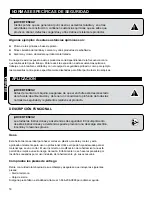
ENGLISH
ENGLISH
5
SPECIFIC SAFETY RULES
SAFETY INSTRUCTIONS
5. Service
a) Have your power tool serviced by a qualified repair person using
only identical replacement parts.
This will ensure that the safety of the
power tool is maintained.
b) When servicing a tool, use only identical replacement parts.
Follow instructions in the maintenance section of this manual. Use of
unauthorized parts or failure to follow maintenance instructions may create
a risk of electric shock or injury.
1) Hold tool by insulated gripping surfaces when performing an operation
where the cutting blade may contact hidden wiring or its own cord.
Contact with a “live” wire will make exposed metal parts of the tool “live” and
shock the operator.
2) Use clamps or another practical way to secure and support the work
piece to a stable platform.
Holding the work by hand or against your body
is unstable and may lead to a loss of control of the tool
3) Do not cut into existing walls or other blind areas where electrical
wiring may exist.
If this situation is unavoidable, disconnect all fuses or
circuit breakers feeding the worksite.
4) Never leave the trigger locked “ON”.
Before plugging the tool in, check
that the trigger lock is “OFF”. Accidental start-ups could cause injury.
5) Keep hands away from the cutting blade.
Do not reach under the material
being cut. The proximity of the blade to your hand is hidden from your sight.
6) Keep hands from between the gear housing and saw blade holder.
The
reciprocating motion of the blade holder can pinch your fingers.
7) Do not use dull or damaged blades.
Bent blades can break easily or
cause kickback.
8) Before starting to cut, turn tool “ON” and allow the blade to come to
full speed.
Blade can chatter or vibrate if speed is too slow at the beginning
of the cut and possibly cause kickback.
9) Always wear safety goggles or other suitable eye protection when
using this tool.
Use a dust mask or respirator for applications which
generate dust.
10) Secure material before cutting it.
Never hold it in your hand or across your
legs. Small or thin materials may flex or vibrate with the blade, causing a
loss of control of the tool.
11) Make certain all adjusting screws and the blade holder are tight before
making a cut.
Loose adjusting screws and holders can cause the tool or
blade to slip and loss of control may result.
12) Use protective gloves when grasping the blade to remove it from the
blade holder.
The blade is sharp and may be hot after prolonged use.






































